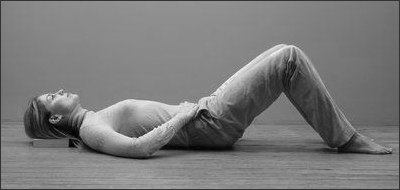Have you ever felt the need to find a way to manage back pain, to play your instrument better, to increase your confidence, to recover faster from a serious accident, to take control of certain aspects of your life, or to ease some of the difficulties of old age?
Can it be that there is a skill that can be learned which provides a 'yes' answer to all of these? According those that that have tried the Alexander Technique, the answer is, there is.
The key concepts of the Alexander Technique are: the recognition of the force of habit, inhibition and non-doing, unreliable sensory appreciation, sending directions and the primary control of the use of the self.
Recognition of the Force of Habit
Man is beset by his own habits. Not that habits are a bad thing. we could not live without them. We have limited capacity for processing information. Thus,making regularly repeated activities habitual and (to a degree) unconscious allows us to function in the present. The way we walk is habitual: wed do not often think about the process of walking while talking to a companion (or, increasingly, on the mobile phone) as we carry on our daily life. And so on...
However, some habits are harmful: the way we bend may cause us pain; the way we play the violin may prevent us from reaching our potential as a violinist. The Alexander Technique is a means of accessing dysfunctional habits and consciously choosing to replace them with better ones. It is a means of exercising choice in the way we respond to the stimulus of life.
This 'means whereby' we access and change habits is described by the four remaining concepts of inhibition, giving directions, unreliable sensory appreciation, and the primary control of the use of the self, ideas which interlock to form the Alexander technique.
Inhibition
Firstly, in order to give ourselves choice, we need to prevent of inhibit our immediate reaction to initiate a habit.
This starts with inhibiting any psycho-physical distortions (e.g. tensions) which are about to interfere with our response. Inhibition is a two-stage process which involves firstly pausing before reacting and then preventing the distortion which is about to intervene.

Sending Directions
Once this inhibition has taken place, we are in a position to work out a means of reacting differently. To do this we need to give our self two sets of guiding instructions or orders. One set establishes a coordinated state of the organism and the other gives consent to a chosen response. This course of action is not without its difficulties; the most important is due to our unreliable sensory appreciation.
Unreliable Sensory Appreciation
This concept means exactly what it seems to, namely, that our feelings (in particular our bodily sensations) may not be reliable. In practical terms our familiar old habits are likely to feel comfortable (even if they are causing pain or other disturbance). Any new kind of response may feel uncomfortable, awkward or even painful. This is not a defect in the organism but an adaptive characteristic. Our limited capacity for processing information means that we learn to walk as toddlers, for example, we take into account all sorts of sensations. The manner of standing and walking becomes habitual and unconscious. This enables other activities to occupy our attention.
If, however, we want to change our manner of walking - for example, in order to prevent a backache - any change is likely to feel initially uncomfortable, awkward or stilted.
The Primary Control of the Use of the Self
This is the unifying feature in the process of practising the Alexander Technique. In fact, there are two key concepts here: firstly, primary control and secondly, the use of the self.
The term primary control refers to both an anatomical entity and a mental activity, that is both an underlying physiological mechanism and the means of controlling it.
"I wish to make it clear that when I employ the word 'use', it is not in that limited sense of the use of any specific part, as, for instance, when we speak of the use of the arm or the use of the leg, but in a much wider and more comprehensive sense of applying to the working of the organism in general. For I recognise that the use of any specific part such as the arm or leg involves of necessity bringing into action the different psycho-physical mechanisms of the organism, this concerted activity bringing about the use of the specific part." (The Use of the Self, 1932, p. 22n).
To summarise, practising the Alexander Technique consists in preventing distortions in the use of ourselves in our everyday activities by means of the primary control of that use. Any changes we make by the process of inhibition and direction may well feel unfamiliar and strange - even wrong, initially. We can check their appropriateness by observing ourselves (as Alexander did with mirrors) or by having other observe us (a teacher, for example).
The above terms used in Alexander's sense, differ subtly from their dictionary definitions; in keeping with their holistic nature, the concepts are not discrete, but merge into each other as an organic whole.
Write a comment